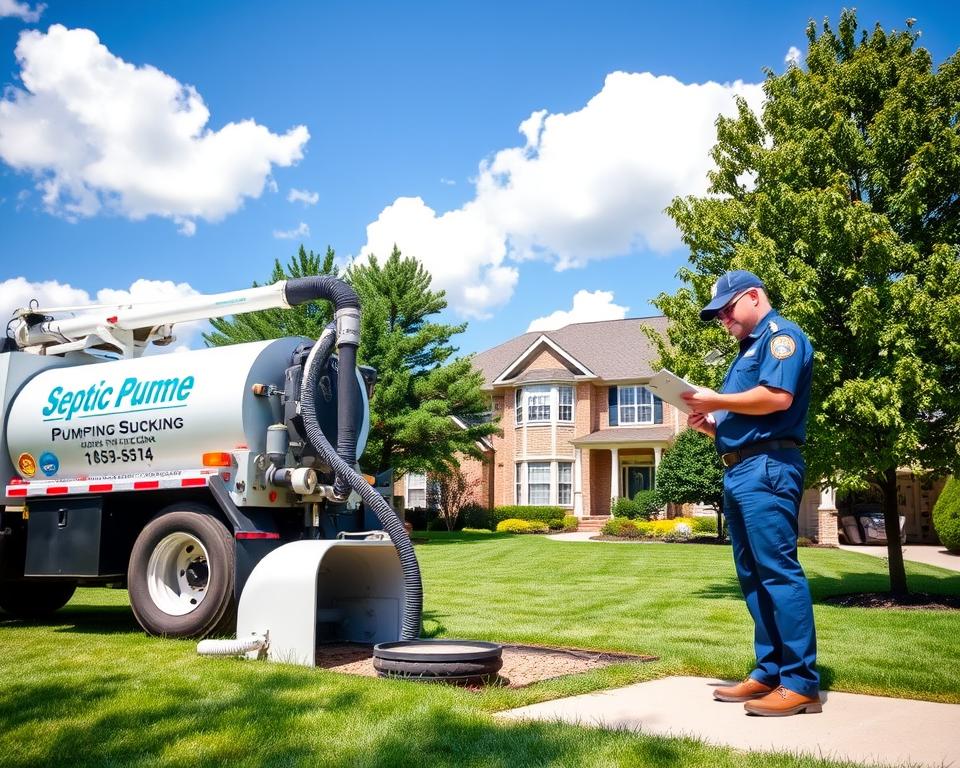Septic Tank Pumping Price Overview
Have you paused to consider about the real price of keeping your septic system in good order, or whether you’re shelling out too much? It’s critical for householders to comprehend the particulars of septic tank pumping prices. Generally, the price tag sits near $420, though it can range significantly. This variance results from elements like your system’s capacity and where you live – septic tank cleaning service.
Routine servicing of your septic tank wards off costly repairs, underscoring the value of understanding service costs. This article will dive into septic tank service pricing comprehensively. This will enable smart budgeting financially for your system’s maintenance.
Key Observations
- Average septic tank pumping runs about $420 USD.
- Prices can range between $290 and $560 subject to various factors.
- Regular servicing prevents more expensive repairs later on.
- Most households need pumping every three to five years.
- Family size and use can impact pumping interval.
Grasping the Value of Septic Tank Pumping
Septic tank pumping is crucial for a efficient effluent system. It extracts solids that, if ignored, cause backups. Regular pumping also avoids bad smells but also sidesteps hefty repair costs.
Ignoring septic tank maintenance can jeopardize our extensive reliance on these systems. Fortunately, reasonably priced services lower the risk of system failure. Regular upkeep lengthens your septic system’s life, guaranteeing efficient operation.
Cost data for septic tank upkeep reveals the value of proactive care. Regular service detects problems before they escalate, avoiding severe damage and hefty repair bills. Routine pumping is a smart move for homeowners to safeguard their asset and enjoy peace of mind.
Average Costs for Septic Tank Pumping
Septic tank pumping commonly ranges between $250 and $600 in cost. Most times, homeowners will spend about $400 for this necessary service. Price variations are driven by elements like capacity, geographic setting, and how often service is scheduled. Standard tanks, around a thousand gallons, usually cost between $225 and $400.
Homeowners should remember the necessity of budgeting funds every three to five years for septic tank cleaning. This regular care relies on the system load and size. It prevents bigger, pricier issues later, proving to be both labor and cost‑effective.

Factors Influencing Septic Tank Pumping Prices
A number of factors are crucial in setting the cost of septic tank pumping. Knowing these details empowers homeowners to plan for these required services wisely.
The capacity is significant a lot. Larger tanks demand more effort and materials to empty, which means elevated fees. The reachability to your tank also greatly affects the price. Tanks set far underground or in hard‑to‑reach locations require more hours and specialized equipment from technicians, thus hiking the labor costs.
Costs can differ widely depending on where you live. This is due to variations in local labor rates and disposal fees. For example, some areas have higher charges for getting rid of waste, affecting the final service cost. Moreover, tanks with heavy solid waste accumulation also see additional fees—anywhere from $100 USD to $300 USD. Plus, the more frequently a tank requires pumping—due to higher household wastewater production—the higher the ongoing expenses.
Septic Tank Size and Its Effect on Cost
The size of your septic tank strongly impacts the cost of its upkeep. Lower‑capacity tanks, such as, those that can hold three‑quarters of a thousand gallons, generally have lower pumping costs, commonly ranging from $175 USD to $300 USD. On the other hand, higher‑capacity tanks, capable of holding up to 1,750 gallons, may incur charges between $400 USD and $700. The majority of single‑family residences have tanks that hold between one thousand to 1,250 gallons, offering a balance between volume and performance.
Families with smaller tanks or higher numbers of occupants often require more frequent pumping services, which improves the overall expense. It’s important to schedule regular septic tank inspections in these situations. This makes sure the tank does not overflow or malfunction, which helps avoid additional costs. By recognizing the link between tank size and service fees, homeowners can make knowledgeable choices regarding their septic systems and their upkeep needs.
Geographic Variations in Septic Tank Pumping Costs
Septic tank pumping costs can differ substantially based on area. In urban areas, the expenses are often higher due to local septic services facing increased overhead. For example, Minneapolis, MN residents may spend between $180 and $280, while those in Portland, OR could see prices from $440 to $750.
The reasons behind these disparities are multifaceted. They include cost of living, demand for septic specialists, and area‑specific regulations. In places where septic services are limited, homeowners might incur higher charges due to the fewer choices. Moreover, tough regulations in some regions can increase the need for higher compliance fees, impacting the cost of services.
Knowing about these geographic cost variances is essential for homeowners. It empowers them to plan their septic maintenance budget more realistically. By recognizing local pricing, they can obtain quotes from specialists prudently, maintaining their septic system effectively without financial strain.
Additional Costs to Consider with Septic Tank Pumping
Homeowners often overlook various additional maintenance costs associated with septic tank pumping. The core cost covers just the basic service, leaving out other potential expenses. Being aware of these can help in preparing a complete budget.
Video line checks, for instance, fall between $250 USD to $500. They offer a non‑invasive look into the system’s condition. Additionally, filter maintenance, which if overlooked can cause system failures, represents another cost.
The window for repairs can be wide, from $100 to $4,000, according to the specific issues. This variability highlights the need of factoring in additional maintenance costs for future budgeting.
Allocating Funds for Septic Tank Maintenance
When planning for septic tank maintenance, it’s vital to adopt a holistic view. This covers a few critical elements. Owing to variable factors, the cost of maintenance can shift considerably. Hence, proper financial planning is indispensable.
To make sure your system operates smoothly and to avoid unforeseen bills, keep these timelines and services in mind:
- Regular pumping: This service is usually required every three to five years.
- Inspections: Budget for around $250 to $1,180 USD for inspections every three years.
- Potential repairs: Set aside a fund for unexpected fixes, which can pop up unexpectedly.
Creating a recurring maintenance calendar with a dependable septic service is crucial. By forecasting these expenses, homeowners can evade the hefty costs tied to neglect. This method secures the longevity and performance of their septic systems.
Typical Indicators That Your Septic Tank Needs Pumping
Keeping watch to your septic system’s condition is vital. Recognize the early clues that suggest your septic tank is due for pumping. Doing so can avert major damage and reduce repair costs.
- Slow drains: Water taking longer to drain in sinks, tubs, or toilets could mean your septic tank is at capacity.
- Unpleasant odors: Bad smells near the septic tank or in your yard are usually urgent signs of a problem.
- Gurgling sounds: Unusual gurgling from your plumbing might show air is trapped because of a blockage.
- Wet spots: Standing water or lush grass patches near the drain field suggest waste seepage from the tank.
- Dark green grass: Grass that is darker and appears robust around the drain field may show leakage of nutrients, hinting at an issue.
Routine checks by septic system specialists can maintain your tank is in good shape. Relying on skilled septic technicians for maintenance avoids these issues, guaranteeing your system’s longevity.
Gains of Routine Septic Tank Inspections
Frequent inspections are central to maintaining your septic system in top condition. They pinpoint potential problems before they become expensive repairs. By hiring professionals for these checks, every part of your system receives a thorough assessment.
The process reviews multiple parts of your system, including waste levels and the drain field’s condition. It ensures that critical parts, like baffles, operate as they should. Finding issues early avoids harmful overflows and safeguards the environment, helping both your home and the wider community.
Getting your septic tank evaluated every three years can save you a lot of money. It stops bigger issues from occurring due to neglect. This not only saves on repair costs but also ensures your peace of mind.
| Inspection Aspect | Importance |
|---|---|
| Waste Level Assessment | Prevents overflow and backups |
| Drain Field Evaluation | Identifies saturation and function |
| Component Functionality Check | Ensures proper system operation |
| Early Problem Detection | Saves on repair costs |
Ways to Cut Costs on Septic Tank Pumping Prices
Homeowners trying to lower septic tank pumping costs have multiple strategic options. Arranging group services with neighbors is one smart method. This involves coordinating with others nearby to schedule services together, potentially landing group discounts. It’s a way to boost community bonds while controlling expenses more economically.
Another practical approach is to enroll in maintenance plans with septic service providers. These plans often provide reduced rates for regular check‑ups and pumpings, ensuring septic systems working properly at a lower cost. Homeowners are encouraged to ask about these plans when contacting service companies.
Keeping the septic tank easy to reach can also lower pumping expenses. Clear accessibility means there’s less chance of extra labor charges. It’s wise to keep the area around the tank free from obstructions, permitting straightforward servicing.
Practicing certain habits helps in lengthening the time between pumpings as well. Reducing water usage and curbing garbage disposal use are critical practices. These actions can significantly improve septic system health, decreasing the need for regular maintenance. By following these habits, homeowners can efficiently trim their septic tank pumping costs, safeguarding their wallets and systems.
The Final Word
Making sure consistent septic tank pumping is essential for homeowners who want to keep their waste management system healthy and effective. Being informed about the costs involved allows for smart budgeting. This way, you can secure cost‑effective septic services without hurting your system’s functionality.
Embracing a preventive approach to maintenance is highly beneficial. By looking out for signs that indicate the need for pumping, you can avoid expensive repairs and lengthen your system’s lifespan. Such actions not only enhance your home’s functionality but also deliver you peace of mind.
Ultimately, staying on top of scheduled inspections and timely septic tank pumping is critical for efficient home maintenance. By giving importance to proper planning and focusing on affordable septic service, you’ll guarantee your septic system remains working and effective for many years.

